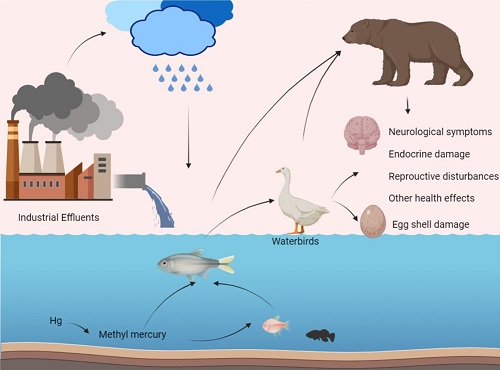Mercury (Hg), a heavy metal that has been in use since antiquity in one form or the other, can result in a broad range of adverse health impacts, including behavioral, neurochemical, hormonal, and reproductive changes in both humans and animals. Wildlife is at the front lines of mercury contamination problems globally due to the tendency of mercury to biomagnify in ecosystems. Toxic mercury levels have been found in minks, otters, loons, and other piscivorous birds and wildlife. Mercury occurs in a variety of inorganic and organic forms and is released from coal-fired power plants, waste incinerators, cement plants, wastewater treatment plants, medical products which end up in the lakes, rivers, and forests that wildlife depends on. Methyl mercury is a highly toxic form that gets distributed throughout the body and is stored mainly in the liver, kidneys, and brain. Birds poisoned with mercury exhibit reduced egg-laying. Mammals may show impaired motor skills that affect their ability to hunt and find food. Larger predatory species are most at risk because mercury accumulates with each step up the food chain. The impact of methylmercury poisoning in wildlife is documented by various toxico-epidemiological and experimental studies conducted throughout the world. However, the severity of the damage to the wildlife in this era of deteriorating environmental conditions is not well understood. All these effects combine to create a severe threat to wildlife survival.
Methyl mercury
Methylmercury (MeHg) is the most important of the different chemical forms of mercury. It is a toxic derivative of elemental mercury. Methylation of inorganic mercury occurs by the action of anaerobic microorganisms in both fresh water and seawater such as wetlands, lakes, and reservoirs. Once methylmercury is released from microbes, it enters the food chain and can biomagnify to toxic concentrations in predatory species like birds and animals, where the rate of mercury intake exceeds the rate at which it can be excreted. Central and peripheral nervous systems are generally considered primary targets for MeHg toxicity because MeHg is efficiently absorbed from the diet and can readily pass the blood-brain barrier. In addition, it can readily cross the placenta and concentrate selectively in the fetal brain. Reproductive effects of MeHg in mammals range from developmental alterations in the fetus, which produce physical or behavioral deficits after birth, to fetal death.
Mechanism of action
Mercury interacts with sulphydryl groups of enzymes and other proteins, thus blocking several metabolic processes in the body. It prevents the synthesis of essential proteins, leading to cellular degeneration and necrosis. Methyl mercury also inhibits the enzyme choline acetyltransferase. This leads to acetylcholine deficiency, contributing to signs and symptoms of motor dysfunction. It can also disrupt ion exchange across voltage-gated and ligand-gated ion channels. Through disruption of mitochondrial electron transport chain, it produces reactive oxygen species, which further contributes to neuronal injury.

Animals
Mercury poisoning in animals occurs by ingestion of fish contaminated with organomercurials or from water contaminated with industrial waste. Many research findings evinced toxic levels of mercury in various wild animals like panthers, river otters, minks, raccoons, and bats. Signs of mercury intoxication in animals include anorexia, hypothermia, nervous and renal dysfunctions, gastrointestinal symptoms, cardiovascular disturbances, shock, or death. Toxicity in mammals primarily manifests as central nervous system damage, including lethargy, various visual impairments, ataxia, limb paralysis, tremors, sensory and motor deficits, and behavioral impairments. Such dysfunctions could reduce survival in wild carnivores, for example, by impairing their ability to catch prey. Furthermore, mercury exposure can suppress immune function, result in neurochemical changes in the brains, potentially damage muscle cells, and impair reproduction. In addition, toxic mercury concentrations get accumulated in various organs like the liver, kidneys, and muscles.
Birds
Mercury exposure to birds may occur during various life stages because of the long half-life of mercury in living beings (e.g., 116 days in young loons) and the high mobility of birds. Clinical signs of acute MeHg poisoning in birds include reduced food intake leading to weight loss, progressive weakness in wings and legs leading to difficulty flying, walking, and standing, and an inability to coordinate muscle movement. In addition, female birds may deposit accumulated mercury into their eggs. It can lead to reduced hatchability due to early mortality of embryos, eggshell thinning, reduced clutch size, increased numbers of eggs laid outside the nest, and aberrant behavior of juveniles. Toxic levels of mercury have been detected in various wild birds like eagles, wood thrushes, warblers, pheasants, loons, herons, Eurasian coots, and mallards in various parts of the world.
Conclusion
Mercury is thus a toxicant of great environmental concern that poses a huge threat to wildlife. Tackling mercury pollution is an urgent need to mitigate this toxic threat across the entire world. Strict measures are required to reduce the rampant use of mercury and control its emission into the environment from various sources so that the safer survival of our wildlife species can be assured.
For further reading
- Kalisińska, E., Lisowski, P., Salicki, W., Kucharska, T. and Kavetska, K., 2009. Mercury in wild terrestrial carnivorous mammals from north-western Poland and unusual fish diet of red fox. Acta Theriologica, 54(4), pp.345-356.
- Louise C A. The Effects of Environmental Mercury Contamination on Wild and Domestic Animals. Appro Poult Dairy & Vet Sci. 1(2).
- Sandhu, H. S., and Brar, R.S., 2009. Textbook of Veterinary Toxicology. 2nd Kalyani Publishers, New Delhi, Pp. 108-113.
- Scheuhammer, A., Braune, B., Chan, H.M., Frouin, H., Krey, A., Letcher, R., Loseto, L., Noël, M., Ostertag, S., Ross, P. and Wayland, M., 2015. Recent progress on our understanding of the biological effects of mercury in fish and wildlife in the Canadian Arctic. Science of the Total Environment, 509, pp.91-103.
- Wolfe, M.F., Schwarzbach, S. and Sulaiman, R.A., 1998. Effects of mercury on wildlife: a comprehensive review. Environmental Toxicology and Chemistry: An International Journal, 17(2), pp.146-160.









Be the first to comment